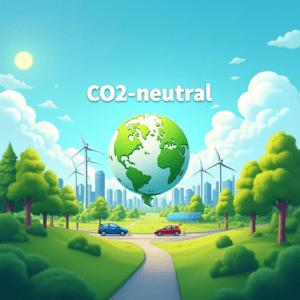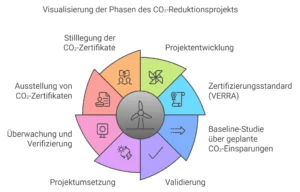Greenhouse gases play a crucial role in the Earth’s climate system. They are responsible for trapping heat in the atmosphere, which is essential for the survival of all living beings. However, in recent decades, human activities, particularly the burning of fossil fuels and deforestation, have led to a dramatic increase in these gases.
Carbon dioxide, methane, and nitrous oxide are the main contributors to this process. While they naturally occur in a certain balance, humans have disrupted this equilibrium, leading to an increase in global temperatures. This warming has far-reaching consequences for the climate, ecosystems, and ultimately for us humans.
The effects of increased greenhouse gas concentrations are already being felt. Extreme weather events such as heatwaves, floods, and storms are becoming more frequent, placing a strain not only on the environment but also on our way of life. The oceans are warming and acidifying, threatening marine life and impacting fish stocks.
Moreover, glaciers and polar ice are melting, leading to rising sea levels that threaten coastal regions. It is crucial that we become aware of the role of greenhouse gases and take action to reduce their emissions. Only then can we mitigate the worst effects of climate change and ensure a sustainable future for future generations.
Key Takeaways
- Greenhouse gases like CO2 and methane are mainly responsible for climate change and global warming.
- Deforestation leads to soil erosion, species extinction, and changes the climate by reducing CO2 sinks.
- Transportation causes air pollution and is a major contributor to CO2 emissions.
- Industry is responsible for a significant portion of global greenhouse gas emissions.
- Agricultural practices like monoculture and over-fertilization contribute to greenhouse gas emissions and soil erosion.
- Energy production from fossil fuels is one of the main sources of greenhouse gas emissions.
- Natural disasters such as floods and storms are intensified by climate change.
- Consumption behavior, especially in industrialized countries, significantly contributes to pollution and resource exploitation.
Impacts of Deforestation
Deforestation is another central issue closely linked to climate change. Forests are not only habitats for countless species but also important carbon sinks. They absorb CO2 from the atmosphere, thus helping to regulate the climate.
When we cut down forests, we not only release the stored CO2, but we also reduce the Earth’s ability to absorb future emissions. The reasons for deforestation are varied: agriculture, urbanization, and illegal logging are just some of the factors leading to the destruction of these valuable ecosystems. The consequences of deforestation are devastating.
It leads not only to a loss of biodiversity but also to a deterioration in soil quality and increased erosion. The destruction of forests also directly impacts the climate, as fewer trees mean less evaporation of water, resulting in less precipitation. This can lead to droughts in certain regions and threaten water supplies.
Additionally, indigenous communities often rely on forests for their livelihoods. The destruction of their habitats leads to social conflicts and deepens poverty. It is essential that we commit to protecting and reforesting forests to safeguard both the climate and the livelihoods of many people.
The Importance of Transportation
The transportation sector is one of the largest contributors to greenhouse gas emissions worldwide. Whether through cars, trucks, airplanes, or ships – the transport of people and goods significantly contributes to air pollution and climate change. The rise in global trade and increased mobility has led to an explosion in energy consumption within the transportation sector.
Fossil fuels remain the primary source of energy in this sector, which means we urgently need to find alternative solutions to reduce emissions. Shifting to sustainable modes of transport is crucial for climate protection. Electric mobility, public transportation, and cycling are some of the options we should consider.
Furthermore, innovative technologies such as hydrogen propulsion or biofuels can help minimize CO2 emissions in the transportation sector. It is up to all of us to make conscious decisions and choose eco-friendly alternatives. Only through a collective change in our transportation behavior can we make a significant contribution to reducing greenhouse gas emissions and fighting climate change.
The Role of Industry
| Category | Metrics |
|---|---|
| Production | Production volume, production costs, production time |
| Labor | Employment rate, working conditions, wage level |
| Environmental impact | Emissions, waste production, resource consumption |
| Innovation | Research expenditure, patents, technology transfer |
Industry is another significant factor in the context of climate change. It is responsible for a large portion of global greenhouse gas emissions, especially through processes such as the production of cement, steel, and chemicals. These industries require large amounts of energy, often derived from fossil fuels, leading to high CO2 emissions.
Additionally, many industrial processes generate other harmful gases such as methane or fluorinated gases, which have a much higher greenhouse potential than CO2. To reduce the industrial impact on the climate, we must develop innovative approaches to reducing emissions. This can be achieved through the use of renewable energy, more efficient production methods, or recycling.
Companies should also take responsibility and integrate sustainable practices into their business models. Consumers can also influence this by choosing products that are made in an environmentally friendly way. By working together towards a sustainable industry, we can not only combat climate change but also create new economic opportunities.
The Impacts of Agriculture
Agriculture has a significant impact on the climate, contributing both to greenhouse gas emissions and the destruction of ecosystems. Livestock farming is a major source of methane emissions, while the use of fertilizers releases nitrous oxide. Additionally, converting forests into agricultural land leads to deforestation and thus the release of CO2.
The way we produce and consume our food directly impacts the climate. To minimize the negative effects of agriculture on the climate, we need to promote sustainable practices. This includes the use of agroecological methods, avoiding chemical fertilizers and pesticides, and reducing meat consumption in favor of plant-based diets.
Encouraging local food production can also help reduce the CO2 footprint. By making conscious decisions and supporting sustainable agriculture, we can not only protect the climate but also ensure the health and well-being of future generations.
The Importance of Energy Production
Energy production is a central aspect in the fight against climate change. The majority of our energy still comes from fossil fuels like coal, oil, and gas, leading to high CO2 emissions. The transition to renewable energy sources such as wind, solar, and hydropower is therefore essential to drastically reduce emissions.
These technologies not only offer a clean source of energy but also contribute to creating new jobs in a growing sector. Furthermore, we also need to think about energy consumption. Efficient technologies and energy-saving measures can help reduce overall energy demand.
Promoting energy storage solutions is also important to balance fluctuations in renewable energy. By rethinking our energy consumption and switching to sustainable sources, we can make a significant contribution to combating climate change while reducing our dependence on fossil fuels.
The Role of Natural Disasters
Natural disasters are an alarming sign of the advancing climate change. More frequent and intense storms, floods, and droughts are direct consequences of global warming. These events have devastating effects not only on the environment but also on society: They destroy habitats, endanger food supply systems, and lead to massive economic losses.
Particularly vulnerable communities are often the most affected and may not have the resources or capacity to adapt to these changes. It is important to recognize that we cannot be mere observers of these developments; rather, we must take active measures to prepare for future disasters and mitigate their effects. This can be done by building infrastructure that is more resilient to extreme weather conditions or by implementing early warning systems to evacuate at-risk areas.
Furthermore, we should address the causes of climate change and work together on solutions to reduce the frequency and intensity of such natural disasters in the long term.
The Impacts of Consumption Behavior
Our consumption behavior has a tremendous impact on the climate and the environment. The way we choose and consume products – whether clothing, electronics, or food – significantly contributes to the demand for resources and thereby influences emissions across various sectors. Often, it is the cheaper products that are associated with a high environmental burden: From manufacturing to transport to disposal – each step has its own ecological footprint.
To bring about positive change, we need to rethink our consumption behavior and make conscious decisions. Buying locally produced goods or products with a lower ecological footprint can make a big difference. Reducing consumption through upcycling or second-hand purchases also helps conserve resources and minimize waste.
By acting responsibly as consumers and supporting sustainable alternatives, we can not only reduce our own impact on the climate but also encourage companies to adopt more eco-friendly practices.
If you’d like to learn more about the causes of climate change, I recommend checking out your personal CO2 balance. On the website Your CO2 Balance, you can find out how much CO2 you cause and which areas of your life contribute the most. This knowledge can help you take targeted actions to reduce your own carbon footprint and actively combat climate change.
FAQs
What are the main causes of climate change?
The main causes of climate change are the increased concentration of greenhouse gases in the atmosphere, mainly caused by human activities such as burning fossil fuels, deforestation, and industrial processes.
What role does the burning of fossil fuels play in climate change?
Burning fossil fuels like coal, oil, and gas releases large amounts of carbon dioxide, which acts as a greenhouse gas and contributes to global warming. These emissions are one of the main causes of climate change.
How does deforestation contribute to climate change?
Deforestation leads to the release of stored carbon dioxide into the atmosphere and reduces the ability of forests to absorb carbon dioxide. This intensifies the greenhouse effect and accelerates climate change.
What impact do industrial processes have on climate change?
Industrial processes such as cement and steel production generate large amounts of greenhouse gases, particularly carbon dioxide. These emissions also contribute to climate change.
What role do natural factors play in climate change?
Natural factors such as volcanic eruptions and changes in solar activity can cause short-term fluctuations in climate, but they have less influence on long-term climate change compared to human activities.



